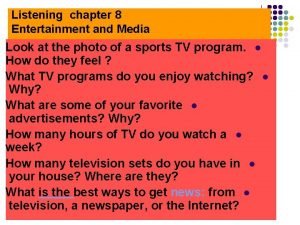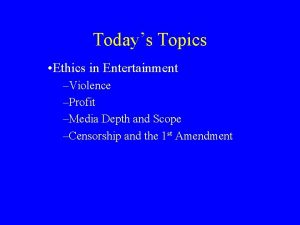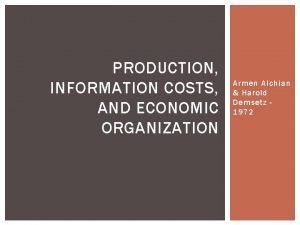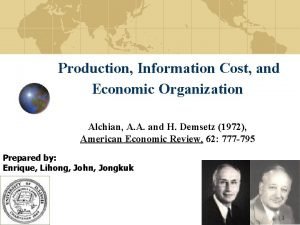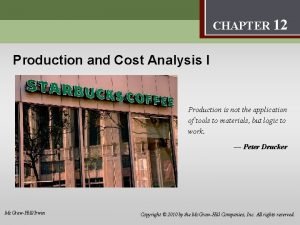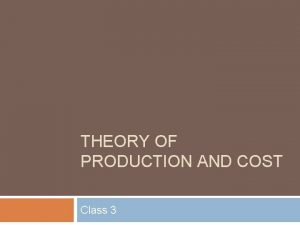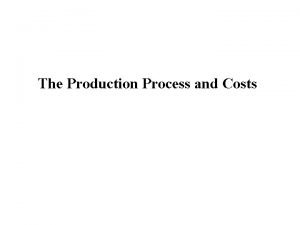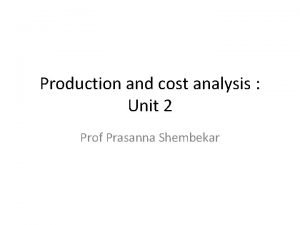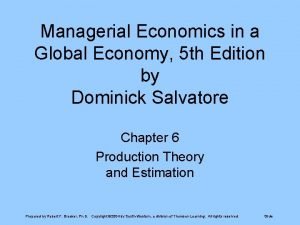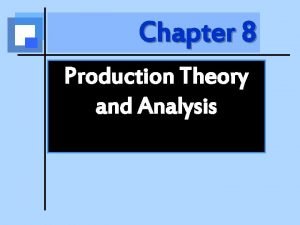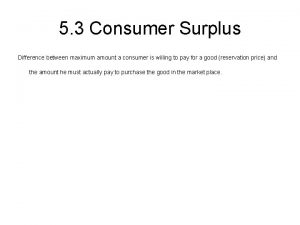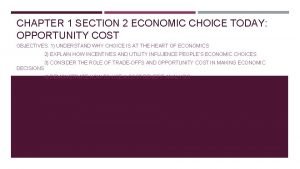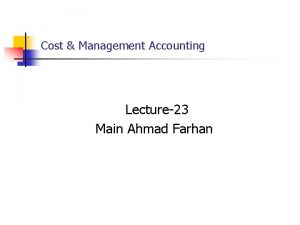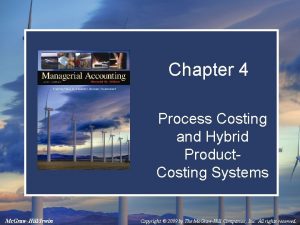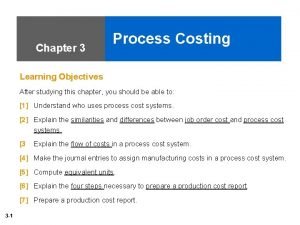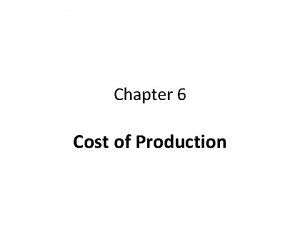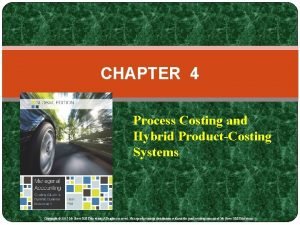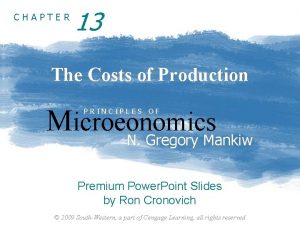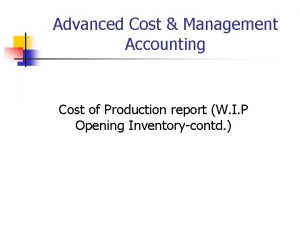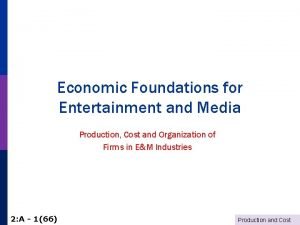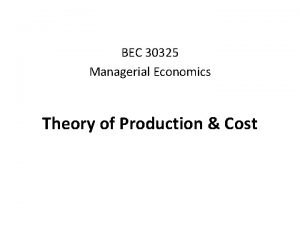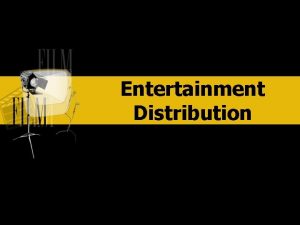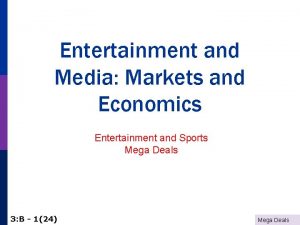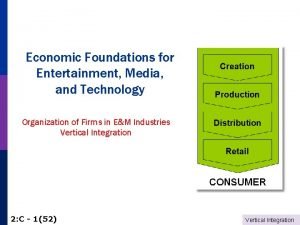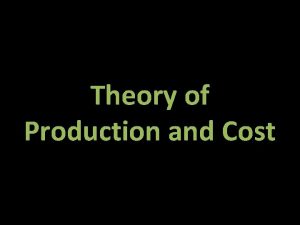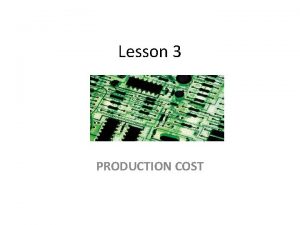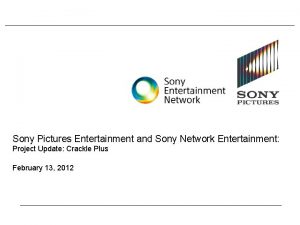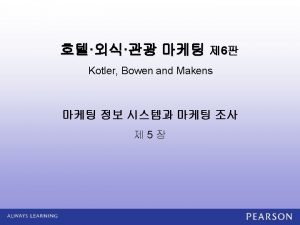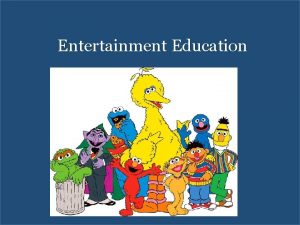Economic Foundations for Entertainment and Media Production Cost


































































- Slides: 66

Economic Foundations for Entertainment and Media Production, Cost and Organization of Firms in E&M Industries 2: A - 1(66) Production and Cost

Technology and Production p Conventional aspects of cost and production for a commodity p Similarities to and differences from entertainment and experience goods 2: A - 2(66) Production and Cost

Classical microeconomics apply to the production of toasters and books Brand: Cuisinart Price: About $80 1, 200 pages. Retail: About $200 Marginal Cost? Fixed Cost? Total Cost? Behind the price: How much does it cost to make a Cuisinart toaster? Costs of production · Variable vs. fixed costs · Marginal cost · Prices, costs and profits 2: A - 3(65) Production and Cost

Does it apply to Spotify? 4 2: A - 4(66) Production and Cost

Classical microeconomics apply to the market structure for toasters Brand: Cuisinart Price: About $80 There are many brands Lots of competition Probably not unusually profitable Behind the market structure · Economies of scale – can small firms survive? Examples: Breweries, Car makers Counterexamples: Paper, Books, Toys, Small appliances In the middle: Movie studios · Economies of scope – is there a competitive advantage in producing more than one product? 2: A - 5(65) Production and Cost

There are many movie studios This looks like a competitive market 6 2: A - 6(66) Production and Cost

Familiar Market Outcomes in Commodity Markets Ø Ø Market power Monopoly (Branding) Ø Market segmentation (Low and high end toasters) Ø Does the idea of “branding” extend to movie studies or TV networks? To the products they produce? 2: A - 7(65) Production and Cost

Producing Experiences · Most of the interesting differences are on the demand side. (We examined in Part 1. ) · Features of Entertainment and Media Firms · Conventional economics explains much of production · There a few special features of some E&M production 2: A - 8(66) Production and Cost

Producing Experiences Economic Foundations for Production · Production functions – the technology · Costs of production – an element of competition · Economies of scale and scope – produce market advantages · Technological change – markets evolve as technology changes (e. g. , movie theaters) 2: A - 9(66) Production and Cost

Production Function Making movies has a well established production “technology. ” 2: A - 10(66) Production and Cost

Spotify Production Function Output(s)? What does Spotify produce/sell Inputs? What resources do they use? 2: A - 11(66) Production and Cost

Characteristics of the Creative Industries p What do we mean by “the creative industries? ” n n p Not synonymous with experience goods: E. g. , amusement park vs. art There are distinguishing features of creative industries These features have implications for the organization of market activities: n n Contracts among producers Market organizations for distribution 2: A - 12(66) Production and Cost

Staging in Production p Creating experience goods n n p Music: Composition, Creation Books: Authorship Delivering experience goods n n Pandora, Spotify, etc. Prentice Hall Publisher, Amazon Distributor Different production processes at work in different stages. p Contrast this to car manufacturers vs. dealerships p 2: A - 13(66) Production and Cost

Creative Industries Some characteristics of production in creative industries that are unlike more conventional production n Producers’ emotional connection to the output – e. g. , art, music, performances of many types … not toasters Assembly of widely diverse skills for production - movies, sports Durable products and durable rent streams. Contrast to one-off sale of the toaster. 2: A - 14(66) Production and Cost

Caves on Creative Industries Some characteristics of demand in creative industries that are unlike more conventional goods n n n 2: A - 15(66) Uncertainty of demand – difficult to resolve using market research Differentiated products – different consumers have very different interests in the same product. The role of time in consumption Production and Cost

Noteworthy Features of Production in Entertainment and Media · · Multiple stages of production · Outputs are often downstream inputs: Think movies · Creation, Distribution, Exhibition Creation stage is often very labor intensive · · Delivery (exhibition) may be very capital intensive · · · Little substitution between labor and capital Less technologically oriented Not always - animation is a major exception May allow substitution away from labor Technological advance Applications: Books, Movies, TV, Newspapers, Radio, Recorded Music, Live Performance (Theater, Concerts) 2: A - 16(66) Production and Cost

Production Processes Sometimes Allow Substitution of Factors · Live theater – the “cost disease” results from little opportunity to substitute capital for labor · The trend toward animated movies is an example of substituting capital for labor. The figure shows different combinations of capital and labor that can be used to produce 100, 000 units. E. g. , the USPS can use people or machines to sort 100, 000 pounds of mail. 2: A - 17(66) Production and Cost

Now, after 500 performances, our producers have told us and our union that in order to cut costs they will chop our string section in half, releasing five musicians and “replacing” them with a synthesizer piped in from another room. 2: A - 18(66) The cost disease. Production and Cost

Production Functions · · · Output Inputs – the factors of production The “process” The amount producted, Q, depends on “inputs” or factors of production. Conventional inputs: Capital, labor, materials used in making movies Unconventional inputs: Music used in distribution and production in stores and offices. The crowd used to create big sporting events. Labor Capital Materials 2: A - 19(66) Production and Cost

Industrial Production Function 2: A - 20(66) Production and Cost

BB&B Production Function Output: Distribution of things to consumers p Inputs: p n n n Capital: Physical, Financial Labor Energy Materials Music How do they use music? p Why do they use music? p How do they pay for it? p 2: A - 21(66) Production and Cost

Live Performance Production is Unconventional p p p 2: A - 22(66) Production function – One “stage” Simultaneous production and consumption Feedback between consumers and producers n Concerts n Big Sports n e. Bay watchers Production and Cost

About Production Functions Factors and Factor Intensity · · · Higher education is very labor intensive, but less so over time. Broadway (legitimate) theater – very labor intensive and there is almost no opportunity to substitute capital for labor Creating Music – labor intensive, but some opportunities to substitute capital for labor. Major League Baseball – only the game on the field is labor intensive. Most of the rest of the process is very capital intensive. Casino – capital intensive. It takes relatively few people to keep a casino working, and fewer over time. 2: A - 23(66) Production and Cost

Multiple Output Processes · Managing a multiplex – Two outputs from one production facility · Concessions (the primary source of profits) · Movies (the secondary profit center) · Casino – · Gambling · Food and entertainment · One capital intensive output, one labor intensive 2: A - 24(66) Production and Cost

Multiple Output Processes · Professional sports performance · The sport: Outcome on the field and the signal for · · broadcasting Concessions including food and merchandise Sky boxes in stadiums · Music Distribution: Many products – many distribution channels · Performances (public) that also distribute recorded versions · · plus t shirts and souvenirs Music videos Music for private consumption Music input to other entertainment Music blended into advertisements 2: A - 25(66) Production and Cost

A Mathematical Model for a Movie Theater Marberger, D. , “Optimal Pricing for Performance Goods, ” Managerial and Decision Economics, 1997, 18, 5, 375 -381. (1) Movie theaters sell two products: Tickets, T = the number of movie goers who come to theater Food (concessions), F = amount of food sold that night (2) Mathematical statements for the two products Tickets= Demand for movie tix: T(Pt, W). Marginal cost = Ct Depends on factors like weather (W), the movie, and ticket price, Pt Food = Demand for food: F(Pf, T, O). Marginal cost = Cf Depends on the price of food, Pf, the number of movie goers, T, and other things (O) including the movie. (3) Central (and intuitively reasonable) result d. F/d. T > 0 More movie goers buy more food. Selling more tickets will result in selling more food. 2: A - 26(66) Production and Cost

Mathematical Model for a Movie Theater p The manager must decide on the ticket price n n p (1) Ignore the relationship between tickets sold and food sold or (2) Figure out both tickets and food at the same time. Ignoring the connection to food The theater owner acts like a ticket monopolist: Profit = T*Pt - T*Ct - fixed costs p Maximize by equating marginal revenue to marginal cost: Pt + T*(d. Pt/d. T) = Ct The resulting price is a monopoly outcome. Pt = Ct (marginal cost) plus a monopoly effect 2: A - 27(66) Production and Cost

Mathematical Model for a Movie Theater p Considering the connection of movie tickets and food p The theater owner tries to maximize profits from tickets and food at the same time. Recognizes the ticket price will affect the amount of food they sell. Total Profit = Tickets profit + food profit = (T*Pt - T*Ct ) + (F*Pf – F*Cf) They must equate MR to MC in both parts. For the tickets part, now Pt + T*(d. Pt/d. T) + Pf*(d. F/d. T) = Ct The ticket price is lower than if the food is ignored Pt = Ct - T*(d. Pt/d. T) - Pf*(d. F/d. T) [the second minus part is positive. ] 2: A - 28(66) Production and Cost

Movies and Food Ticket Price Pt is the monopoly price if the owner ignores the effect of tickets on sales of food. Pt|f is the ticket price if the owner also considers the effect of tickets sold on sales of food. Pt Pt|f Marginal Cost minus food effect Food Effect Demand Tickets Conclusion: To account for the effect of ticket prices on the demand for the main profit center (food), theater owner drives down the ticket price. 2: A - 29(66) Marginal Revenue Production and Cost

Two Product Monopolist 2: A - 30(66) Production and Cost

Multistage Production Is Common This is not the same as joint production of more than one product. Early stages are inputs to later ones. 2: A - 31(66) Production and Cost

Multiple Stages in Production The TV broadcast Network The game on the field Team Capital Players Capital Equipment The viewer Cable Operator F(x) Equipment Labor F(x) TV Sports What’s better for this process, one firm or two? Disney Pixar, or Disney/Pixar? 2: A - 32(66) Production and Cost

The Costs of Production · Fixed cost: Not a function of output. Capital · Sunk cost: One time, nonrecoverable costs (Often very significant in the movie business) $Multimillion model of Titanic · Variable cost: Variable with respect to output · Labor · Materials · Marginal cost: Avoidable cost of one more (less) unit · Operating Profit = Gross Revenue - Costs 2: A - 33(66) Production and Cost

Box Office Revenue 1997 -2013 2: A - 34(66) Production and Cost

Production Costs 2: A - 35(66) Production and Cost

2003 http: //www. slideshare. net/Miss. Connell/film-distribution-costs http: //www. edwardjayepstein. com/x-rar 1. htm 2: A - 36(66) (2003) Marketing Costs: $ 85 M U. S. Box Office: $ 150 M World incl. US: $ 417 M (#113 all time – on a list that does not correct for inflation, currency, or anything else. ) Rights: WB 50 M Sony 75 M Production and Cost

2: A - 37(66) Production and Cost

Changing Economics for Stars p p Before 2010: $10 M, $15 M, $20 M, … Trend since about 2010: n n p Small or no up front Except for Angelina Jolie – first choice for Gravity but could not agree on a deal. Sandra Bullock got $20 M for signing. Unusual now. CB 0 contract (Cash-Break zero – percentage after break even) Far smaller total compensation for start Why? n n 2: A - 38(66) Economics of film making Falling demand for star power in movies Production and Cost

Production cost Exhibitors Sandra Bullock $100 M At least $300 M $ 77 M = $20 M + 15% x Studio net (45% ) + Misc TV, DVD, etc. George Clooney ? Net so far $231 M - ? Promotion and advertising ? Probably $50 M - $100 M Other distribution ? SUCH “FIRST DOLLAR” GUARANTEED BOX OFFICE DEALS FOR ACTORS ARE BECOMING RARE, THE HOLLYWOOD REPORTER SAID, BECAUSE STUDIOS NOW WANT TO RECOUP ALL THE COSTS FOR EXPENSIVE PRODUCTIONS BEFORE SHARING THE PROFITS WITH TALENT. BULLOCK’S CO-STAR GEORGE CLOONEY, GRAVITY DIRECTOR ALFONSO CUARÓN AND PRODUCER DAVID HEYMAN ARE ALSO BELIEVED TO HAVE “BACK END” PAY DEALS. HTTP: //WWW. INDEPENDENT. CO. UK/ARTS-ENTERTAINMENT/FILMS/NEWS/GRAVITY-STAR-SANDRA-BULLOCK-SET-TOEARN-70 M-WINDFALL-FOR-OSCARNOMINATED-FILM-9157448. HTML 2: A - 39(66) Production and Cost

Budgets and Box Office Revenues 2: A - 40(66) Production and Cost

d an s d fa an u M an le t ok Sa le Bo 2: A - 41(66) ra tin g it of l) M al Pr g in 1. 36 O pe n tio 1. 36 pp ho (S . 59 bu 1. 94 r . 86 1. 08 1. 29. 70 st ri 2. 15 Di . 75 1. 40 La bo Record Label $10. 80 Re nt ar k M ct ur in Di g s et tri Co in b op g ut an io er n d at Pr iv e o m ad ot vt io. a n Ar nd Ro t D i Ro st i ya De sco ya lty ve un to t lo to Re pm s Co co en m t po rdin se g O ve Ar ra rh tis n d ea t L d yr an ic d is t Di st r ib O ut pe io ra n tin g Pr of it CD Breaking Down Music Costs CD Costs and Profits Retailer $6. 20 Consumer 2. 55. 97 Fixed Costs Variable Costs Sunk Costs Operating Profit Production and Cost

Production and Cost Functions? Most of the marginal cost of something sold for download from i. Tunes is the royalty. E. g. , the 99 cent single track triggers about 70 cents in royalties. 2: A - 42(66) Production and Cost

Economies of Scale · Working definition: Declining average cost · Market based definition: Competitive advantage of large size · Sources · Supply based: Technical, · Demand based: Networks · Indivisibilities: Lumpiness 2: A - 43(66) Production and Cost

Economies of Scale in E&M · · · 2: A - 44(66) Cablevision Professional sports Publishing/Movies – Backlists of titles Casinos Movies Television Production and Cost

Economies of Scope · Cost effect · Cost(Q 1, Q 2) < Cost(Q 1, 0) + Cost(0, Q 2) · · Cablevision and Newsday Applications · · · Cable TV, Internet Mobile phone network Basketball, Hockey teams · Not the effect behind vertical integration · News media owning the sports team? Sky News motivation for owning Manchester United 2: A - 45(66) Production and Cost

Technological Advance (Marginal) Cost Reduction Digital setup in newspapers Synthesized instruments in Broadway Musical Orchestras Digital distribution of movies Less Cost Reduction in Performance Industries: Baumol’s Cost Disease of the service sector Live theater, Orchestra, Education 2: A - 46(66) Production and Cost

Search Technology - The Long Tail Reduces the marginal cost of distribution and promotion. p Locate the world market for small or obscure goods – books - information p A result of the Internet and search technology. p 2: A - 47(66) Production and Cost

2: A - 48(66) Production and Cost

Labor Saving Technological Change in Card Games in Casinos 2: A - 49(66) Production and Cost

Digitizing Entertainment – Technical Advance in Delivery of Existing Forms · Music · MP 3 - affects distribution, not creation · Pop music without musicians. · Literature: · E-books – Kindle (Amazon), Nook (B&N) · E-zines (Slate. com) · Web based news services (NYTimes. com) · Movies: · · 2: A - 50(66) Creation – digital equipment, Pixar animation Distribution – digital transmission without film Distribution – mode Netflix Exhibition – digital projection (expensive) Production and Cost

“Book” Production Costs 2: A - 51(66) Production and Cost

Music Production and Distribution Costs n n 2: A - 52(66) Studio quality recording with free software and without studio or graphic design. (XBloome: X Marks the Spot. Distribution, bypassing the labels. i. Tunes, Sound. Cloud From XBloome's X Marks The Spot website: As maybe the first album ever, 'X marks the spot' was produced exclusively using Free Software (Open Source) and without a professional studio or graphic designers. With this 'proof of concept' album, XBloome have debunked several prejudices about feasibility, professionality and quality of free and self-made productions. “ (www. xbloome. com) Production and Cost

2: A - 53(66) Production and Cost

Sound. Cloud’s Conventional Entry into the Music Streaming Market 2: A - 54(66) Production and Cost

Who should bear the cost? (About $75, 000/screen) Film makers? Distributors? Exhibitors? Equipment makers? New York State? The conversion is over 80% complete in the U. S. 2: A - 55(66) Production and Cost

http: //www. rollingstone. com/movies/news/how-digital-conversion-is-killing-independent-movietheaters-20130904 2: A - 56(66) Production and Cost

U. S. Movie Screens Source: National Association of Theater Owners 2: A - 57(66) Production and Cost

2: A - 58(66) Production and Cost

Theater owners cannot price digital. PRICING MOVIE TECHNOLOGY General Seniors Children Cabin in the Woods (Georgetown) 12 11 9 th Cabin in the Woods (7 & H) (Not digital) 12 9. 25 9 th Loews on 84 St. New York 13 9. 50 Titanic Imax 18 17 15 Titanic Real 3 D 16 15 13 Wrath of the Titans in Real 3 D 16 15 13 2: A - 59(66) Production and Cost

2: A - 60(66) Production and Cost

3 D 2 D Format: Existing projecting systems; 20 new movies in 2008 -2010. 3 D Format: About 1000 existing projection systems plus 250 IMAX. Requires digital projection. “It’s not always as good as they say it is…” “I’m not so sure our customers even know we have it…” Theater owner, New Mexico. Can it be priced? 2: A - 61(66) Production and Cost

2: A - 62(66) Production and Cost

http: //www. marketplace. org/topics/business/movie-theaters-move-beyond-ticket-price The simple explanation is that fewer people are going to the movies, but they are paying more for their tickets. Mostly we're talking about 3 -D movies, which are more expensive. But higher ticket prices aren't necessarily great news for theater owners. Theaters have to share box office revenue with studios, says business professor William Greene of the Stern School of Business at NYU. 2: A - 63(66) Production and Cost

3 D Economics p 30 3 D Movies n n p “Avatar” - $250 M Benefit: Net addition to profit $80 M (Dreamworks) Obstacle: Digital Projection n Insufficient screens (3000 needed for an opening) Uncertain financing for theater digital projection (financial crisis) Pricing the Upgrade ($25 tickets) 2: A - 64(66) Production and Cost

3 D can be priced. “Digital” cannot. 3 D 2 D 2: A - 65(66) Production and Cost

4 D can be priced. A subsidiary of a distribution and exhibition company, CJ 4 DPlex provides the technology for 112 4 D theaters in more than 20 countries throughout Asia, Europe and the Americas. Tickets Stateside cost $22 on average, but for that premium price, moviegoers get to kick back in motion-based seating in a theater that spays water, emits odors and jerks visitors around, all synchronized to the on-screen action. Moviegoers seem interested in taking this particular ride. Over its 13 -day 4 D engagement, for example, “Transformers: Age of Extinction” generated $105, 016 in ticket sales compared to a U. S. average of $44, 054 during the same period. That’s an 138% improvement. Likewise, “Dawn of the Planet of the Apes” capitalized on its action-heavy plot to deliver $94, 247 in ticket sales in one 4 DX location over its first 13 days compared to an industry average of $38, 404. That’s 145% better. 2: A - 66(66) Production and Cost
 Alur post
Alur post Economic foundations of strategy
Economic foundations of strategy Entertainment and media listening
Entertainment and media listening Rose media and entertainment
Rose media and entertainment Entertainment products and services
Entertainment products and services Ethical issues in entertainment
Ethical issues in entertainment Economic growth vs economic development
Economic growth vs economic development Production, information costs, and economic organization
Production, information costs, and economic organization Production, information costs, and economic organization
Production, information costs, and economic organization Cost and production analysis
Cost and production analysis Theory of production cost
Theory of production cost Cobb-douglas production function
Cobb-douglas production function Economic growth vs economic development
Economic growth vs economic development Economics unit 1 lesson 2 difficult choices
Economics unit 1 lesson 2 difficult choices Economic region of production diagram
Economic region of production diagram Economic region of production diagram
Economic region of production diagram Marginal rate of technical substitution
Marginal rate of technical substitution The law of diminishing marginal rate of substitution
The law of diminishing marginal rate of substitution Economic production quantity formula
Economic production quantity formula Cost accumulation and cost assignment
Cost accumulation and cost assignment Cost accumulation and cost assignment
Cost accumulation and cost assignment Cost pools
Cost pools What is a period cost on the income statement
What is a period cost on the income statement Cost control and cost reduction difference
Cost control and cost reduction difference Standard cost system
Standard cost system Distinguish between average cost and marginal cost
Distinguish between average cost and marginal cost Cost control and cost reduction difference
Cost control and cost reduction difference Job order cost flow
Job order cost flow Ordering cost and carrying cost
Ordering cost and carrying cost Actual cost and opportunity cost
Actual cost and opportunity cost Cost control and cost reduction project report
Cost control and cost reduction project report Cost control and cost reduction project report
Cost control and cost reduction project report Cost behavior patterns
Cost behavior patterns Economic opportunities of media and information
Economic opportunities of media and information Economic choice today opportunity cost
Economic choice today opportunity cost Cost of production report example
Cost of production report example Operation costing is a hybrid of
Operation costing is a hybrid of Objective of process costing
Objective of process costing Production cost definition
Production cost definition Hybrid costing system
Hybrid costing system The costs of production chapter 13
The costs of production chapter 13 Cost of production report example
Cost of production report example Cost of factors of production
Cost of factors of production Theory of production cost
Theory of production cost Iso 22301 utbildning
Iso 22301 utbildning Novell typiska drag
Novell typiska drag Tack för att ni lyssnade bild
Tack för att ni lyssnade bild Ekologiskt fotavtryck
Ekologiskt fotavtryck Shingelfrisyren
Shingelfrisyren En lathund för arbete med kontinuitetshantering
En lathund för arbete med kontinuitetshantering Underlag för särskild löneskatt på pensionskostnader
Underlag för särskild löneskatt på pensionskostnader Tidböcker
Tidböcker Anatomi organ reproduksi
Anatomi organ reproduksi Förklara densitet för barn
Förklara densitet för barn Datorkunskap för nybörjare
Datorkunskap för nybörjare Tack för att ni lyssnade bild
Tack för att ni lyssnade bild Hur skriver man en debattartikel
Hur skriver man en debattartikel Magnetsjukhus
Magnetsjukhus Nyckelkompetenser för livslångt lärande
Nyckelkompetenser för livslångt lärande Påbyggnader för flakfordon
Påbyggnader för flakfordon Tryck formel
Tryck formel Publik sektor
Publik sektor Kyssande vind
Kyssande vind Presentera för publik crossboss
Presentera för publik crossboss Teckenspråk minoritetsspråk argument
Teckenspråk minoritetsspråk argument Vem räknas som jude
Vem räknas som jude Klassificeringsstruktur för kommunala verksamheter
Klassificeringsstruktur för kommunala verksamheter


